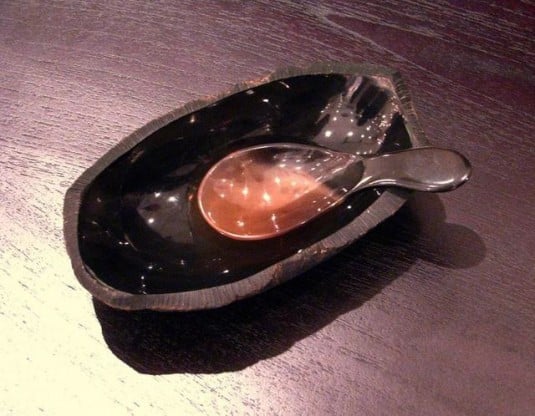
May 18, 2011
The State of Green Furnishings
Photo: Paul Clemence. A chair could change a century and perhaps a planet. It will have to, eventually, but the greening of the home-furnishings industry is taking longer than we hoped for. Though we see evidence of one or two singular aspects of sustainability, systems-thinking is harder to find when it comes to residential furniture […]
Photo: Paul Clemence.
A chair could change a century and perhaps a planet. It will have to, eventually, but the greening of the home-furnishings industry is taking longer than we hoped for. Though we see evidence of one or two singular aspects of sustainability, systems-thinking is harder to find when it comes to residential furniture design and manufacturing.
Asked for an honest assessment of the “State of Green and Sustainability” at New York trade show, ICFF, (International Contemporary Furniture Fair), we traipsed through three very-cool satellite showrooms, one high-end showroom, and the whole ICFF show floor (at the Javits Center) before we finally heard smart talk from a visionary manufacturer. Someone is doing their homework and we loved hearing words like “biocide release, change of custody in the supply chain and resource conservation.” But much more homework needs to be done throughout the industry. Herewith is our first Report Card and highlights of the green and sustainable trends from ICFF 2011 as well as galleries, shops, and showrooms around New York City.
While we did see exciting trends with aspects of green consciousness, we saw less innovation than we hoped for. For instance, when we asked about where sustainable materials come from, we got answers like “Well, with the teak, we try, sometimes the source is unknown and with the horn bowl, we have no idea what animal it comes from, I think it’s a by-product.” Or, when it comes to plastic light fixtures, one answer was, “Well, it’s a plastic that’s been used for years so that means it’s safe.” I guess the speaker skipped the training on MSDS (Material Safety Data Sheets) and opted instead for a AMPS, (A Mani-Pedi Session; for those who haven’t heard this expression before, it refers to a partially-sexist comment, “she was getting a manicure/pedicure when she should have been doing her homework”).
 Bowl made of horn, animal unknown. Photo: Paul Clemence.
Bowl made of horn, animal unknown. Photo: Paul Clemence.
On a more promising and happier note, we are delighted to report on trends and highlights seen on the show floor and at Noho (http://www.nohodesigndistrict.com/) and Soho showroom openings.
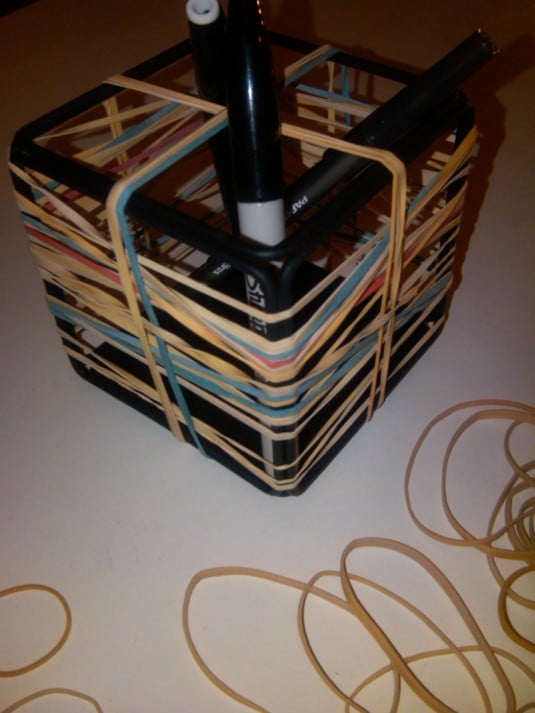 Craighton Bernman’s rubber band holder. Photo: Jade Dressler.
Craighton Bernman’s rubber band holder. Photo: Jade Dressler.
Joinery is hot. No glue! No nails! The use is the structure!
We noticed designers everywhere by-passing the by-products of labor and materials and the less-sustainability of glue, nail or screw joinery to ingeniously craft designs which fit together naturally. From the rubber band holder by Craighton Bernman, whose changing design is also its function, seen at the “Use Me” show, the 6th produced by the American Design Club featuring 45 young American designers of “unapologetically functional objects” to Oscar Magnus Narud’s Keel series of very macho feeling metal wedged-into-wood stools and furnishings, (the exhibit is called “’Make Me’/ Butch Craft”) at the legendary Soho design lab, Moss, and finally to Tom Dixon does Ikea with style plus stools by Tom Dixon at ICFF, the satisfying feeling of effortless joining is a new green trend. And it is older than time. We like the phrase “joinery as ornament” from Thos. Moser, a traditional manufacturer where the dovetail has been an everyday basic for centuries.
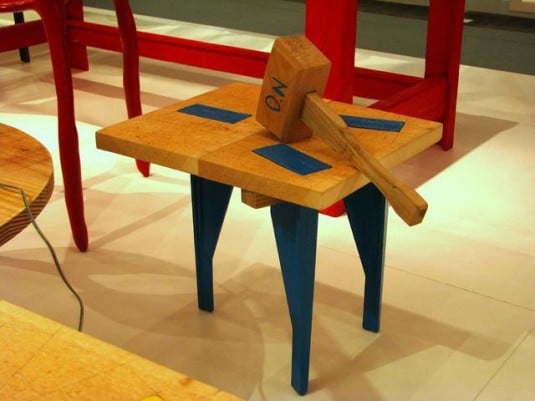 Moss’s Keel series, by Oscar Magnus Narud. Photo: Paul Clemence.
Moss’s Keel series, by Oscar Magnus Narud. Photo: Paul Clemence.
 Tom Dixon stools at ICFF. Photo: Paul Clemence.
Tom Dixon stools at ICFF. Photo: Paul Clemence.
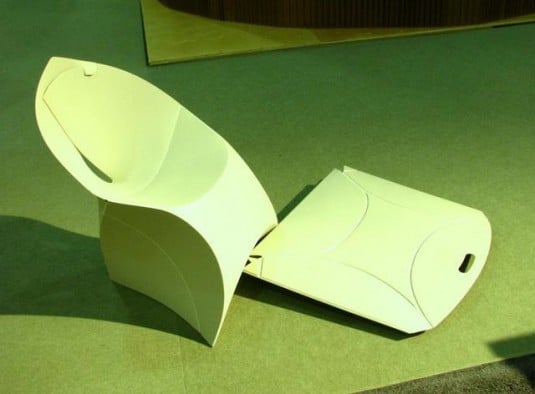 The Flux chair. Photo: Paul Clemence.
The Flux chair. Photo: Paul Clemence.
A Combo-Chair Could Change a Century: We loved the Flux chair for its easily transportable, space-saving, lightweight and foldable design, ingenious for outdoor or indoor use. However, the material is “plastic, just plastic” which made us want to introduce them to our next applicant for a green scholarship, a chair made of 78% bio-plastic.
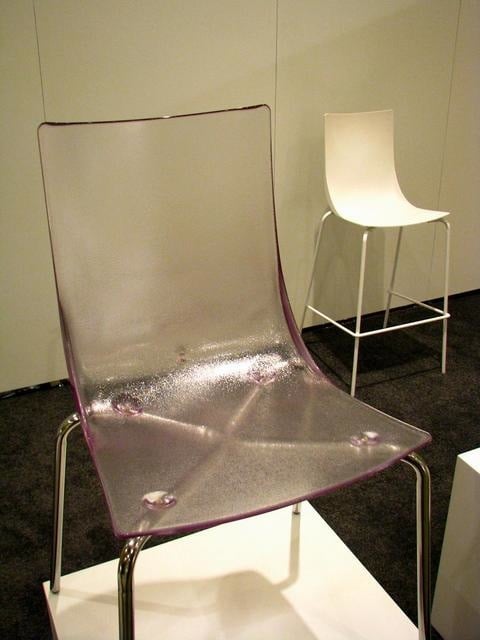 OC Design’s Reiya Natural chairs. Photo: Paul Clemence.
OC Design’s Reiya Natural chairs. Photo: Paul Clemence.
The simple, colored and clear “plastic” industrial-use chairs in the Reiya Natural Collection by OC Design are fabricated in bright colors with 78% bio-based content. A US-based company with a smart alternative to traditional plastics, made from renewable resources like corn, tapioca, potatoes, sugar and algae, it is a start to whole-cycle thinking. Alas, although 100% “recyclable,” the chairs are not biodegradable. We wished we could connect OC Design to Flux and permaculture farmers. It’s time for designers to start collaborating and combine their singular green ideas into thorough solutions, before oceanic trash islands, like the Pacific Trash Vortex, now twice the size of Texas, expand and poison even more aquatic life.
Green Light Go: It’s an instant turn-on when someone crashes through a category previously unexamined by a designer’s eye. The sustainable design innovation Grade “A” goes to Plumen, winner of the Brit Insurance Design of the Year 2011, with their sculpturally elegant low energy light bulb, a happy alternative to the huge, geriatric-looking compact florescent bulbs we know.
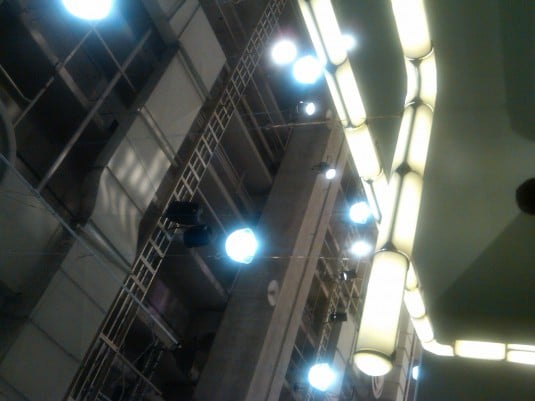 Endless Light, by Jason Miller for Roll & Hill. Photo: Jade Dressler.
Endless Light, by Jason Miller for Roll & Hill. Photo: Jade Dressler.
Taking a beverage break at ICFF, we spied Jason Miller for Roll& Hill’s tubular LED light fixture which led us to the cutting edge applications of LED lighting by top designers at Roll & Hill. One of our favorite designers, Lindsey Adelman, also designed for them. Her Knotty Bubbles leads us to the next important green trend.
 Lindey Adelman’s chandeliers. Photo: Jade Dressler.
Lindey Adelman’s chandeliers. Photo: Jade Dressler.
Choose Artisans vs. Throwaway Culture: When asked about sustainability in their products, many reps will say, “Well, it’s recyclable,” or better, depending on the item itself, “It is built for centuries with the hopes people will pass it down through generations.” This we do agree with and our future heirloom prize goes to Lindsey Adelman’s Burst, a chandelier hanging in a vast industrial space, whose hand-blown glass orbs, spikes detailed like vintage jewelry attached with hinged-cast brass stamens float like a planet organism dressed for the opera.
 Cordule Kehrer’s Bow Bins, for Areaware. Photo: Jade Dressler.
Cordule Kehrer’s Bow Bins, for Areaware. Photo: Jade Dressler.
Again and Again, Adaptive Re-use: An A-plus for the most humorous and smartly fresh mash-up of post-consumer waste and age-old sustainable traditions of basketry goes to Bow Bins from New York-based design label Areaware created by German designer Cordula Kehrer. The sustainably harvested rattan and reclaimed plastic waste bins are not only a comment on “trash” itself, but they’re produced by the indigenous Aeta craftspeople of the Philippines via the fair trade NGO Preda.
 Douglas Thayer’s benches made out of re-purposed broadwalk planks. Photo: Paul Clemence.
Douglas Thayer’s benches made out of re-purposed broadwalk planks. Photo: Paul Clemence.
The planks of Coney Island’s boardwalk, playground for centuries of boisterous crowds, get a new life of Zen-contemplation in the serene concrete and wood benches exquisitely made by Douglas Thayer. The twisted screws from the reclamation are kept as artistic detailing, and like the solid and spiritual amusements of a Buddha under a tree, the seats are naturally resistant to rot.
 Relative Space. Photo: Paul Clemence.
Relative Space. Photo: Paul Clemence.
Finally, Some Material Sense: While the commercial architecture and building industry is at the forefront of green with the LEED standards, the home furnishings industry has no such guidelines. It was a relief to link up with the highly knowledgeable Brian Greenberg, of the family-run Relative Space. Brian spoke about the importance of transparency at every step of the manufacturing process, a clear reason he was invited to present in the boardrooms of Google – to our ears was a true sign of innovation. Brian mentioned the Pharos Project, the closest the industry is getting to a LEED certification-like system, in connection with his work with Google, “a network of building professionals and manufacturers committed to transparency as a core value on the path to sustainability.”
We will speak more in depth on our conversation with Brian on this Green Transparency trend and others we have discovered at the shows, such as Green Connection, featuring a Berlin-based clothing collection which digitally traces and connects its owners and the steadfastness and the Green Lure of the Timeless, with a conversation with a family member of Austria’s sixth-generation glass dynasty, Lobmeyr, and many others in the next post.
There are still some more showrooms to see so perhaps the industry’s grades can still rise in time…and be in tune with the times.
JADE DRESSLER is a curator and consultant for consumer brands and private clients on art and design, from content to exhibits, from interiors to clothing collections and has a habit of spawning art interventions in far-flung locales like Portal do Sul on 10,000 acres in Brazil or urban Milan with the Green Provocateur project.
PAUL CLEMENCE is an award-winning photographer (http://paulclemence.com/) who has been shooting most of his life. His work can be seen in exhibitions as well as in major design and lifestyle publications. Over 5,000 people follow his Architecture Photography Facebook page.






